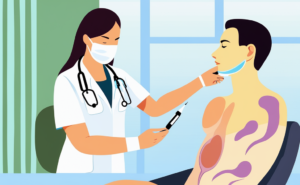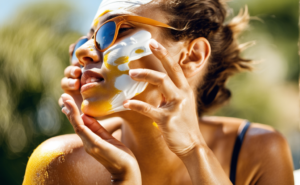Understanding Retentional Acne: A Common Form of Acne
When it comes to skincare concerns, few things can be as vexing as acne. From the occasional pimple to chronic inflammatory acne, there are various types of acne that can wreak havoc on your complexion. In this article, we’ll delve into one specific form of acne: Retentional Acne
What is Retentional Acne?
Retentional acne, also known as **non-inflammatory acne**, is a prevalent form of acne that often plagues individuals with oily skin. Unlike inflammatory acne, which manifests as red, swollen, and painful pimples, retentional acne is characterized by the accumulation of sebum (the body’s natural oil) and dead skin cells within the hair follicles. This buildup leads to the formation of blackheads and whiteheads.
The Science Behind Retentional Lesions

To truly understand retentional acne, it’s essential to comprehend what happens beneath the surface of your skin. Here’s a breakdown:
– Hair Follicles: Your skin is dotted with tiny openings called hair follicles. Each follicle houses a hair shaft and a sebaceous gland that produces sebum.
– Sebum Production: In individuals with oily skin, the sebaceous glands tend to produce more sebum than necessary. This excess sebum can mix with dead skin cells and become trapped within the follicle.
– Blackheads: When the trapped sebum and skin cells oxidize, they turn dark, resulting in blackheads. These are open comedones.
– Whiteheads: In contrast, when the follicle remains closed, the accumulated mixture forms a whitehead, also known as a closed comedone.
Types of Acne: Where Does Retentional Acne Fit In?
Acne comes in various forms, but it’s often categorized into two primary types: inflammatory and non-inflammatory. Retentional acne falls into the latter category alongside other non-inflammatory types like comedonal acne.
Comedonal Acne
Comedonal acne encompasses both blackheads and whiteheads, making it the ideal umbrella term for retentional acne. While it’s generally less severe than inflammatory acne, it can still be a source of frustration for those who experience it.
The Role of Oily Skin
Oily skin is a common predisposing factor for retentional acne. The excess sebum production creates an environment conducive to the formation of comedones. This type of skin often has enlarged pores, which can further contribute to the problem.
How to Manage Retentional Acne

Managing retentional acne involves a combination of skincare practices and, in some cases, medical interventions. Here are some tips:
1. Cleansing: Use a gentle cleanser to remove excess oil and debris from your skin.
2. Exfoliation: Incorporate a mild exfoliant into your skincare routine to help prevent the buildup of dead skin cells.
3. Topical Treatments: Over-the-counter products containing ingredients like salicylic acid can help unclog pores.
4. Professional Help: If your retentional acne is persistent or severe, consult a dermatologist. They may recommend prescription treatments or procedures like chemical peels.
“Clear skin is a journey, not a destination.”
The Battle Against Retentional Acne: Your Personalized Skincare Journey

In the previous section, we explored the ins and outs of retentional acne, shedding light on its causes and types. Now, let’s dive deeper into crafting a personalized skincare routine to effectively manage and prevent those pesky blackheads and whiteheads.
Building Your Retentional Acne-Fighting Arsenal
To effectively combat retentional acne, you’ll need a well-rounded skincare routine that addresses its root causes. Here’s a step-by-step guide to help you get started:
1. Cleansing: The Foundation of Clear Skin
A clean canvas is essential for any skincare routine. Opt for a gentle, sulfate-free cleanser designed for your skin type—preferably one that contains salicylic acid or glycolic acid. These ingredients help exfoliate and unclog pores, reducing the formation of blackheads and whiteheads.
2. Exfoliation: Banish Dead Skin Cells
Regular exfoliation is crucial for preventing the accumulation of dead skin cells that can contribute to retentional acne. However, be gentle with your skin. Over-exfoliating can strip your skin of essential moisture, triggering increased sebum production. Use a mild exfoliant, like a BHA (beta hydroxy acid), 2-3 times a week.
3. Targeted Treatments: Say Goodbye to Comedones
Incorporate acne-fighting products into your routine. Look for those containing active ingredients like:
– Salicylic Acid: A powerful exfoliant that penetrates pores to remove debris.
– Niacinamide: Helps regulate sebum production and reduces inflammation.
– Retinoids: These vitamin A derivatives promote cell turnover and prevent clogged pores.
Remember to patch-test any new product and introduce them gradually to your routine.
Pro Tip: To avoid irritation, apply acne treatments after cleansing and before moisturizing.
4. Moisturize: Hydrate Without Clogging Pores
Even if you have oily skin, moisturizing is non-negotiable. Choose an oil-free, non-comedogenic moisturizer to maintain skin hydration without exacerbating acne.
5. Sun Protection: Shield Your Skin

UV rays can worsen acne scarring and inflammation. Apply a broad-spectrum sunscreen with an SPF of at least 30 every morning, regardless of the weather.
6. Professional Guidance: The Dermatologist’s Touch
If your retentional acne persists or is particularly stubborn, consider consulting a dermatologist. They can prescribe stronger treatments like topical retinoids, oral antibiotics, or even perform in-office procedures such as chemical peels and microdermabrasion.
Lifestyle Tips for Acne-Free Skin

Your skincare routine isn’t the only factor at play. Here are some lifestyle tips to complement your efforts:
– Diet: Some individuals find that certain foods, especially those high in sugar and dairy, can trigger acne breakouts. Consider keeping a food diary to identify potential triggers.
– Hydration: Drink plenty of water to help flush toxins from your body and keep your skin hydrated.
– Stress Management: High-stress levels can exacerbate acne. Practice stress-reduction techniques such as meditation, yoga, or deep breathing exercises.

– Hands Off: Avoid touching your face, as this can transfer bacteria and exacerbate breakouts.
– Clean Makeup Brushes: If you use makeup, regularly clean your brushes and avoid expired products.
– Regular Pillowcase Changes: Changing your pillowcase every few days can help prevent the buildup of oils and bacteria.
Your Journey to Clearer Skin Starts Here
Remember, there’s no one-size-fits-all solution to skincare, and results may take time. Be patient with your skin, stick to your routine, and don’t be discouraged by occasional setbacks. If you’re unsure about which products to use or need personalized guidance, visit The Content Web for a range of skincare options from top brands.
– Click here to stay updated with the latest skincare trends and tips on our blog.
You’ve got this! With the right knowledge and products at your disposal, you’re well on your way to achieving the clear, radiant skin you deserve.

Disclaimer: This article is for informational purposes only and should not be considered medical advice. Consult a dermatologist for personalized skincare recommendations.